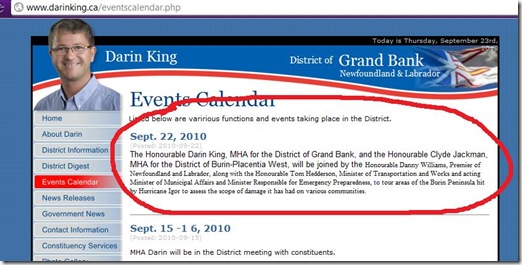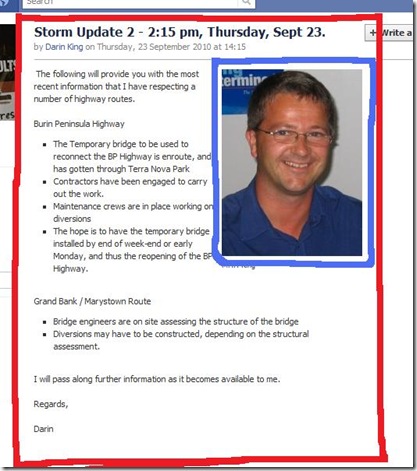One thing is becoming clear a couple of days after Hurricane Igor swept through eastern Newfoundland: for all the weather and other emergencies in the province over the past decade, the province’s emergency response system – municipal and provincial – remains woefully ill-prepared and poorly organized.
All the same, it is nice to know that the province’s major daily newspaper and the provincial agency responsible for emergency response have their priorities in order. As ordinary citizens in Clarenville arrange boatloads of supplies to help people in isolated communities on nearby Random Island, the Telegram and Fire and Emergency Services – Newfoundland and Labrador want to make sure people get their paperwork in order so that those claims for federal assistance or insurance coverage will flow easier.
It’s taken FES two whole days to post a web link to any Igor information and, chronologically, the first release is the one linked: document everything so you can file claims. There’s not very much solid and up-to-date information road closures, power outages or what to do if there is a specific problem. That sort of thing, by the way, is being done in exemplary fashion by the Royal Canadian Mounted Police even though it isn’t their job. For the provincial government, it’s hard to find out any concrete information.
Like say you are in one of those isolated communities and need medical help. Where do you go? Well, apparently the best thing to do is call the local radio station. The government’s ever-vigilant agents will pick up the call and get on the case to deliver a peachy response.
But what if you don’t have a phone?
Maybe you can flag down one of the government-chartered helicopters ferrying politicians hither and yon so these tourists can see for themselves the magnitude of the disaster. They talk to reporters about the sights, incidentally, as if they, themselves were either in it or doing anything substantive about it. With rare exceptions, they aren’t.
In St. John’s, two days later, the city website has one thing about Igor issued after the storm hit. It’s an advisory on where to drop off tree bits. Never mind that people have been using those spots since they started cleaning up – 24 hours and more ago – and that this information is potentially the least important stuff of all the city is responsible to its citizens for.
But still the average citizen cannot tell where the power in town is off and what traffic lights are functioning. This is crucial safety information for those of us trying to get to work or get children to school. None of that is available from the city but residents of the capital could hear a councilor this morning on radio talking up the great city emergency plan.
Then this politician issued the warning that because power is off at the bus depot, they can’t keep up with regular maintenance and might have to reduce service. One wonders why they would take such a drastic measure if there are other city facilities with power and other spaces in the metro area where they might relocate bus maintenance temporarily.
Two mayors hit on the problem this morning while chatting on a local open line show. One is the host of the show and the other called in to advise the world that his community is now officially out of gas at the local gas stations. The only road is down and people are hoping the road will be fixed within 24 hours or so. Other than that there is no plan – apparently – on how someone might get fuel for generators and such into the affected area.
The two mayors talked about lessons to be learned after things were all over. They are absolutely right. That’s the time to figure out what to do and what not to do next time based on experience in this event.
But then one of the mayor’s offered the view that maybe the emergency response this time has not been as good as it should have been.
He’s absolutely right.
The provincial government spends more money today on emergency response than it ever did before. There’s a whole division of government to handle central co-ordination where just a decade ago there only four people for the whole province.
And yet: TASFU.
Things are still fouled up.
The main reason is that for all the lessons readily evident from other emergencies, none have been learned. People want you to believe that 9/11 was a success. Provincially, it was a balls-up on many levels. The official assessment doesn’t come close to noting that. Ditto other, more recent, natural disasters.
Instead, the government system seems geared to the sort of knob polishing that infests sections of the Telegram. Frankly, the provincial municipal affairs minister today sounds much like his predecessor nine years ago. Lots of kudos and vacuous verbiage but not much in the way of solid information that people need. His hasty call to an open line show Thursday came with the breathless claim that he had to rush off to catch another sight-seeing helo-ride. Big fat hairy deal.
Sure emergency response in the province works very well out where real people – road crews, police, fire, linemen, health care workers and so forth – do real jobs. Practicality and good will are the order of the day and that is what worked during 9/11. If Newfoundland Power needs to get to a spot, they will sort it out with the local roads guys. The result will be haphazard and uneven, but then again, that’s what happens when the entire provincial emergency “plan” relies in 2010, as it did in 2001, on people pulling it out of their ass on the day.
Meanwhile, back in the head-shed, in the place that is supposed to be co-ordinating the hockey bag of public and private agencies - assigning scarce resources to the places they will do the most good - heads are just buried deep in the hockey bag. Not much in the way of light is getting through. How else would one explain a political news conference the day of the storm called for exactly the same time as a technical report from Environment Canada and an official of the province’s emergency response division?
You can hear the same old excuses already bubbling up. This was an unprecedented disaster, they are already saying. Yes, it was. And so was the one before that and the one before that and the one before that. We’ve heard it as an excuse for failures every time.
No one should doubt the sincerity of politicians in wanting to relieve the suffering of their fellow citizens. But the time for their intervention is not now. The time for that was last month, last year and five years ago when they should have been making sure the emergency response system worked.
They’ll get another chance to fix things when this current disaster is over, as two mayors suggested already. This time, though, everyone needs to face the things that didn’t work – yet again – and fix them.
Otherwise, when the next hurricane barrels through, we’ll just face the same old fumbled responses and the same “never saw this before” excuses.
The people of the province deserve better.
Let’s put an end to the emergency response TASFU.
- srbp -
Day-ja vue Update: Nothing like a bit of perspective.
Via nottawa, a reminder that this same bullshit – send us your receipts and get your forms properly filled out – came around the last time Mother Nature roared through town on a bender.
Back then of course, the local Reform-based Conservative Party - as the Old man now likes to think of it - wasn’t speaking kindly of the federal Reform-based Conservative Party. So it was Stock Day telling the Old Man to make sure his paperwork was done properly.
And yes, there was also the effort to turn disaster relief into some sort of infrastructure funding program, as if then or now the provincial government didn’t have the cash to fund improvements to roads, bridges and drainage systems. If Marystown mayor Sam Synyard, for example, wants to install bigger culverts on the local roads, then Sam could be and should be looking to the tourists in the helicopter for some cash.
Nottawa’s also got some other pithy observations on emergency response.




